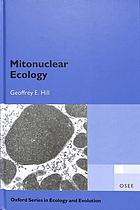Mitonuclear ecology First Edition by Geoffrey Hill ISBN 978-0198818250 0198818254
$50.00 Original price was: $50.00.$25.00Current price is: $25.00.
Mitonuclear ecology First Edition by Geoffrey E. Hill – Ebook PDF Instant Download/Delivery: 978-0198818250, 0198818254
Full download Mitonuclear ecology First Edition after payment

Product details:
ISBN 10: 0198818254
ISBN 13: 978-0198818250
Author: Geoffrey E. Hill
This novel text provides a concise synthesis of how the interactions between mitochondrial and nuclear genes have played a major role in shaping the ecology and evolution of eukaryotes. The foundation for this new focus on mitonuclear interactions originated from research in biochemistry and cell biology laboratories, although the broader ecological and evolutionary implications have yet to be fully explored. The imperative for mitonuclear coadaptation is proposed to be a major selective force in the evolution of sexual reproduction and two mating types in eukaryotes, in the formation of species, in the evolution of ornaments and sexual selection, in the process of adaptation, and in the evolution of senescence. The book highlights the importance of mitonuclear coadaptation to the evolution of complex life and champions mitonuclear ecology as an important subdiscipline in ecology and evolution.
Table of contents:
I The genomic architecture of eukaryotes
Eukaryotic evolution
Eukaryotes are chimeras
OXPHOS and the electron transport system
Massive genomic restructuring
The mitochondrial genome
The retention of a mt genome
Co-location for redox regulation (CORR)
The endpoint of gene transfer
Characteristics of mitochondrial genomes
Classes of genes and abbreviations
Summary
2 Forms and consequences of incompatibility
Oxidative phosphorylation via the electron
transport system
Arenas of mitonuclear interaction
Protein-protein interactions
Protein-DNA interactions
Protein-RNA interactions
Anterograde and retrograde signals
Evidence for mitonuclear coadaptation
Cybrid cell lines
Somatic cell nuclear transfer
Hybrid backcrosses
Hybrid crosses: Classic studies with Tigriopus copepods
Within-species mitonuclear studies
Summary
3 Compensatory coevolution
Mutational erosion
The problem with non-recombining genomes
The mitonuclear compensatory coevolution hypothesis
Compensatory vs complementary coevolution
Evidence for compensatory coevolution
Evidence for N compensation for deleterious mt genes
Experimental evidence of compensatory coevolution
Patterns of mutation and selection in mt and N genomes
Rates of evolutionary change among mt, N, and N-mt genes
Alternative explanations for patterns in comparative data
Whole-gene and whole-genome mechanisms of compensatory coevolution
Compensation through protein subunits
Mitochondrial introgression as a compensatory mechanism
Summary
4 Coevolution, co-transmission, and conflict
Co-transmission and coevolution
The tradeoff between co-transmission and evolability
Sex chromosomes
Sex linkage and co-transmission
Genomic conflict
Nuclear restorer genes
Which dictates eukaryotic evolution: Cooperation or conflict?
Within-individual conflict: Mito vs mito
Endosymbionts
Conflict arising from third genomes
Summary
5 The evolution of sex and two sexes
The evolution of sex
The necessity of recombination
The evolution of sex in light of mitochondrial evolution
Avoiding mutational meltdown
The evolution of two sexes
The evolution of anisogamy
Anisogamy, mating types, and mitochondrial inheritance
Genomic conflict within an individual
Selection against heteroplasmy and selection for
mitonuclear coadaptation
Conflict versus coadaptation
Summary
6 Life eternal in the face of senescence
mt DNA mutation
What underlies mutations in the mt genome?
The evolution of germ lines
Strong selection on germ cells before proliferation and atresia
Strong selection on germ cells after proliferation and atresia
Why plants and most other eukaryotes don’t have a germ line
Selection on the male germ line
Selection across developmental stages
Evolution of senescence
Antagonistic pleiotropy
The mitochondrial theory of aging
The free radical theory of aging
The replication error theory of aging
Apoptotic threshold
Summary
7 Mitonuclear speciation
Traditional species concepts
Speciation fundamentals: Dobzhansky-Muller incompatibility
The mitonuclear compatibility species concept
Mitonuclear coevolution when gene flow is disrupted mt DNA barcodes as evidence for mitonuclear speciation
Mitonuclear speciation driven by mitochondrial-based adaptation
Mitonuclear interactions and gene flow
Allele dominance and introgression of mt and N genes
Sex linkage and speciation
Effects of sex linkage on mitonuclear gene interactions
Darwin’s corollary to Haldane’s rule
What does mitochondrial introgression mean for speciation?
Other potential drivers of mt introgression
Cytoplasmically inherited bacteria
Co-introgression of coadapted mt and N-mt genes
A unified concept of species
Summary
8 Mitonuclear mate choice
Mate choice basics
Choice for shared mt genotype
The mitonuclear compatibility hypothesis of sexual selection
Ornamentation gaps coincide with barcode gaps
Sex linkage and sexual selection
ZW sex determination and ornamentation
Linkage of ornamental traits
Assessment within species
Signals of mitochondrial function
Species-typical vs condition-dependent ornamentation
Carotenoid coloration in birds as a signal of mitochondrial function Summary
9 Adaptation and adaptive radiation
Environments to which mitochondrial adaptation is responsive
Mechanisms for mitonuclear adaptation
Mechanisms of thermal adaptation
Mechanism of adaptation to partial pressure of oxygen
Mechanisms of adaptation to diet
Mechanisms of adaptation to salt and hydrogen sulfide
The next generation of studies of functional mitochondrial adaptation
Evidence for adaptive evolution of mt and N-mt genes
Adaptation arising from standing variation in mt genotypes
Adaptive divergence at species boundaries
Adaptation via mitochondrial introgression
Signatures of adaptive evolution
Adaptive radiation via mt evolution
Human mt genotypes and environment
Summary
10 Epilogue
References
Index
People also search for:
mitonuclear ecology
mitonuclear ecology hypothesis
mitonuclear discordance
mitonuclear
mitonuclear incompatibility
You may also like…
Romance - Contemporary Romance
Mathematics
Biology and other natural sciences
Biology and other natural sciences - Ecology
Romance - Contemporary Romance
Broken Hill Honor 1st Edition by Sheridan Anne 9781096588917 1096588919
Arts - Architecture
Old Philadelphia houses on Society Hill 1750 1840 First Rowman & Littlefield Edition Maicher
Education Studies & Teaching - Studying & Test Preparation
McGraw-Hill Education Preparation for the GED Test 4th Edition Mcgraw Hill Editors
Science (General)
Biology and Ecology of Toxic Pufferfish First Edition Santhanam
Education Studies & Teaching - Studying & Test Preparation












